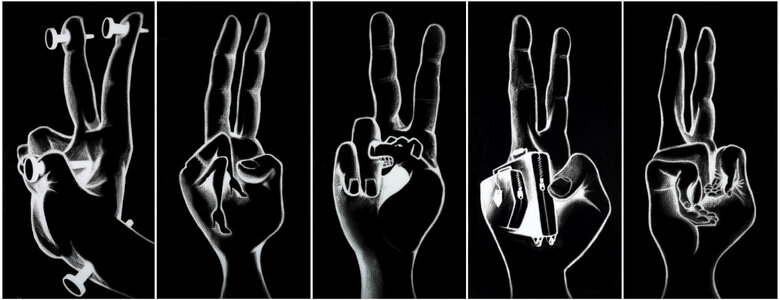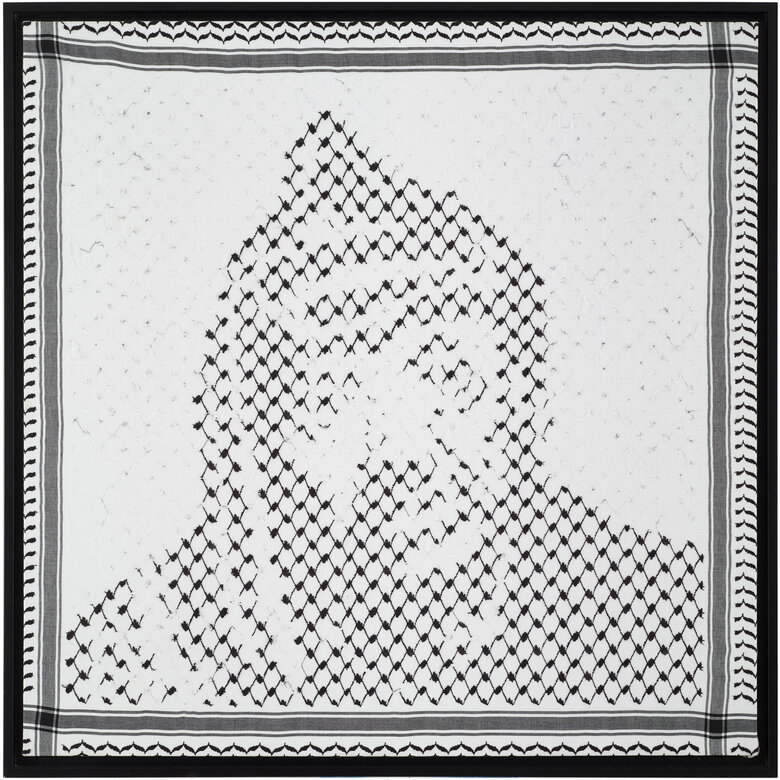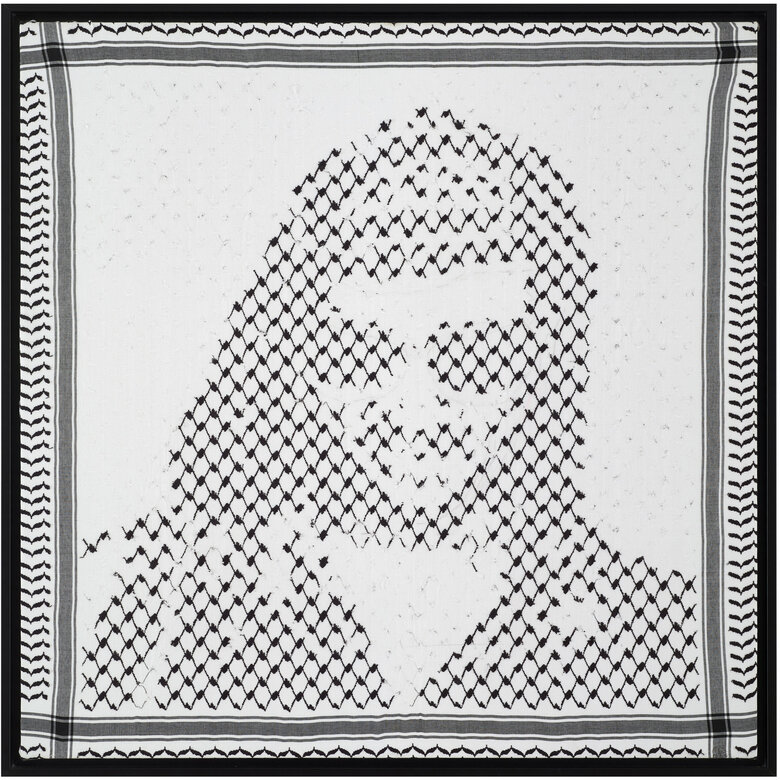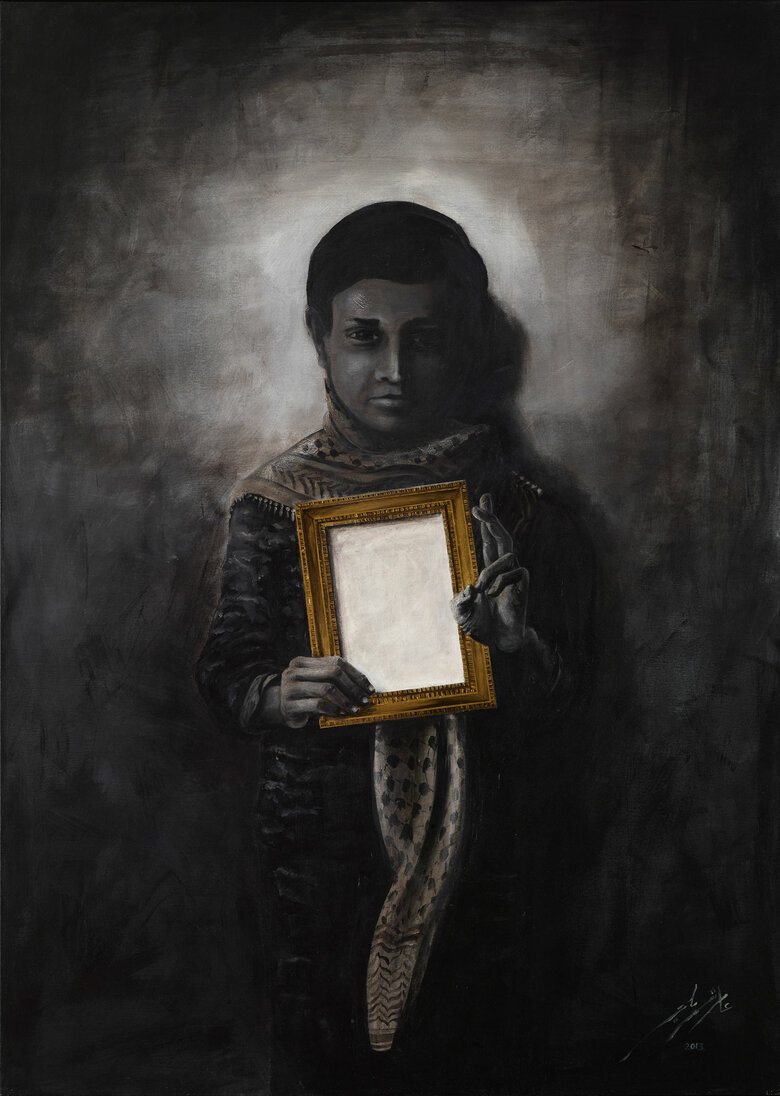Amer Shomali was born in Kuwait in 1981 to a family from Beit Sahour, a Palestinian town east of Bethlehem. Shomali earned a bachelor’s degree in architecture from Birzeit University in 2003, and...

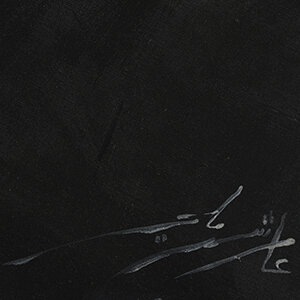
AMER SHOMALI, Palestine (1981)
Bio
Written by WAFA ROZ
Amer Shomali was born in Kuwait in 1981 to a family from Beit Sahour, a Palestinian town east of Bethlehem. Shomali earned a bachelor’s degree in architecture from Birzeit University in 2003, and in 2005 co-founded Zan Studio in Ramallah, a project space for collaborative work in new media and visual arts. The artist studied animation at the Vancouver Institute of Media Arts from 2005 to 2006, and in 2008, he pursued an MFA in animation from Arts University Bournemouth in Poole, England. Shomali works as an animator and illustrator of children’s books, posters, and multimedia productions, and is known for a corpus of work that utilizes a wide variety of digital and traditional media.
During his childhood, the Gulf War forced Shomali and his family to flee Kuwait and relocate to the Yarmouk Palestinian refugee camp in Damascus, Syria. As a young boy living in impoverished conditions and without recreational activities, Shomali found consolation in comic books. Comics such as Superman, Batman, Tintin, and Asterix fed his imagination and introduced him to the creative work of cartoonists. In 1997 his family was granted permission to return to Ramallah, where Shomali was struck by the disparity between the Palestine he’d imagined through his parents’ stories and the reality of a rapidly urbanizing occupied state. His work was later shaped by political changes resulting from failures of the Oslo Accords and the Second Intifada of the early 2000s.
Shomali uses irony to narrate Palestine critically. Humor for him represents resistance and agency, based on his belief that “a nation who cannot make fun of its wounds can never heal them.” Shomali made his debut as a cartoonist in 2007 with the first publication of Zann Al Ann, a monthly comic strip in Philistine Ashabab magazine. His cartoons rely on exaggeration and vibrant colors to relay sardonic messages on the absurdity of public life in the occupied territories. Over time his work has progressed beyond cartooning to encompass animation, digital printing, installation, painting, sculpture, and filmmaking as well.
Among the main themes of Shomali’s work is engagement with the semiotics of images circulated by Palestinian political leadership. This preoccupation is evident in X-ray(2007), in which the artist investigates the notion of victory. On five large-scale black and white prints, X-ray shows a human hand making a peace sign – or a V for Victory – with the remaining fingers folded into the palm and made into objects such as suitcases and sensual female legs. The final panel shows the hand nailed to a wall by its index and two fingers, which are also holding the V shape. Shomali uses the series to demonstrate the fraught nature of political wins in Palestine, suggesting that gains for “peace” or “victory” always come with a high price. Furthermore ,he might reference Hamas’ controversial electoral win in 2006, which resulted in the withdrawal of much needed international aid. In the collaborative project Imaging Palestine, Shomali appropriates the renowned 1936 Visit Palestine poster originally made by Zionist designer Franz Kraus to encourage Jews to visit Palestine. Shomali’s 2009 iteration is titled Post (Visit Palestine) the Guillotine and satirically replaces the wall of Jerusalem in the original with the separation wall dividing the West Bank from Israel.
Inspired by Alan Moore’s graphic novel Watchmen, Shomali made a series of cartoonish self-portraits titled Pagliacci in 2009. They show a clown wearing a frantic smile, red frizzy hair and a polka-dotted green outfit. Pagliacci, which means “clowns” in Italian, is also the name of opera written and composed by Ruggiero Leoncavallo in 1981. A through-line between these tragicomedies is their exploration of the numbing power of entertainment; both suggest that an entertained public can hardly sense the rage and grief of the very clown that amuses them.
Shomali situates contemporary visual culture in relation to sociopolitical change. Following the Palestinian Authority’s 2011 request for statehood from the United Nations, commercial advertisements and billboards with nationalist iconography surfaced throughout occupied territories. In The Icon, 2011, Shomali criticizes this iconography as commodification of struggle. From afar The Icon appears as pixelated pop art portrait of freedom fighter Leila Khaled, but up close, each pixel is a tube of lipstick. The image features 3,500 tubes in fourteen colors.
Frustrated by the ineffectiveness of the Palestinian Authority in the face of the dismal status quo, Shomali chose to use film as a means of revisiting a hopeful event that took place in Beit Sahour in 1987 during the first Intifada. In his award-winning animated documentary, The Wanted 18 (2014), he collaborated with Canadian director Paul Cowan on the true story of a group of intellectuals who decided to become economically independent from Israeli food imports. They acquired eighteen cows to start their dairy farm, which a threatened Israeli army then attempted to shut down. The tragicomedy uses stop-motion animation, illustrations, filmed interviews and, archival material to shed light on nonviolent resistance often overlooked in mainstream media. The film’s translation into English and French granted Shomali international acclaim. In 2012, during the film’s five-year production period, Shomali used 58,000 wooden cubes to create Pixelated Intifada, a life-size sculpture of one of the featured cows.
In the conceptual installation Black Hole (2017), Shomali addresses the economic crisis of the 1991 Gulf War. The artist shows paper notes of devalued Iraqi dinars in plexiglass sheets hang on metal rods, and a circular wall piece made from colorful shredded money. “Only art may one day restore a damaged, void currency to its former value and luster,” says Shomali. In another three-dimensional pixel-based piece titled Broken Weddings (2018), he aligns more than a thousand colorful spools of yarn balls on flat rectangular slabs to produce embroidery motifs typical of folkloric wedding dresses. Broken Weddings are “unperformed songs, unbuilt homes, and unborn children…it stands witness to all that could have been for those whose lives were amputated in 1948.” explains Shomali.
Shomali lives and works in Ramallah, Palestine.
Sources
Amer Shomali. Accessed February 28, 2019. http://www.amershomali.info/biography/.
Amer Shomali, www.amershomali.info/pixelated-intifada/.
Bostonpalestinefilmfest.org. Accessed February 28, 2019. http://www.bostonpalestinefilmfest.org/2015/10/amer-shomali-for-me-making-this-film-meant-rebelling-against-what-a-documentary-should-look-like-a-creative-process-to-reflect-the-spirit-of-the-first-intifada/.
"#8 - The Wanted 18 - Interview - Human Rights Weekend 2015." Vimeo. December 13, 2018. Accessed February 28, 2019. https://vimeo.com/118360538
"'Wanted 18' Hoofs It through Israeli Hunt for Cows on the Lam." Los Angeles Times. June 19, 2015. Accessed February 28, 2019. https://www.latimes.com/entertainment/movies/la-et-mn-wanted-18-review-20150619-story.html.
Annie. "A Second Look at Laughter: Humor in the Visual Arts, Humor: International Journal of Humor Research." DeepDyve. February 22, 2013. Accessed February 28, 2019. https://www.deepdyve.com/lp/de-gruyter/a-second-look-at-laughter-humor-in-the-visual-arts-40nU2uqVuN.
Ecpr, and Ecpr. "2009 Postdam General Conference Programme." Issuu. Accessed February 28, 2019. https://issuu.com/ecpr/docs/2009_postdam_general_conference_pro.
Ggmgggmg. "Was Rorschach's Pagliacci Joke a Real Joke?" Science Fiction & Fantasy Stack Exchange. Accessed February 28, 2019. https://scifi.stackexchange.com/questions/131380/was-rorschachs-pagliacci-joke-a-real-joke.
Hatuqa, Dalia. "Q&A: 'Middle East's Most Powerful Army Chasing 18 Cows'." GCC News | Al Jazeera. March 21, 2016. Accessed February 28, 2019. https://www.aljazeera.com/news/2015/11/qa-middle-east-powerful-army-chasing-18-cows-151111094846819.html.
HumanRightsWatch. "HRW Film Festival - The Wanted 18 Q&A, London 2015." YouTube. October 21, 2015. Accessed February 28, 2019.https://www.youtube.com/watch?v=7Kqnf2GSy4o.
Lionis, Chrisoula. "Peasant, Revolutionary, Celebrity: The Subversion of Popular Iconography in Contemporary Palestinian Art." Academia.edu - Share Research. Accessed February 28, 2019. https://www.academia.edu/11796964/Peasant_Revolutionary_Celebrity_The_Subversion_of_Popular_Iconography_in_Contemporary_Palestinian_Art.
Lionis, Chrisoula. Laughter in Occupied Palestine: Comedy and Identity in Art and Film. London: I.B. Tauris, 2016.
Moore, Alan. "Watchmen Characters." GradeSaver: Getting You the Grade. Accessed February 28, 2019. https://www.gradesaver.com/watchmen/study-guide/character-list.
Murphy, Maureen Clare. "Leila Khaled in Lipstick: Women-focused Art Show Tours West Bank." The Electronic Intifada. February 12, 2017. Accessed February 28, 2019. https://electronicintifada.net/content/leila-khaled-lipstick-women-focused-art-show-tours-west-bank/11717.
News, Weave. "Suhad Babaa - What Is Today's Most Underreported Story?" YouTube. November 11, 2015. Accessed February 28, 2019.https://www.youtube.com/watch?v=JsURM9_U_u8.
Shomali, Amer. "Visit Palestine - Montreal 2012." The Palestine Poster Project Archives. November 27, 2014. Accessed February 28, 2019. https://www.palestineposterproject.org/poster/visit-palestine-montreal-2012.
"Stacy Ryan Ange August 2011 - The ScholarShip at ECU." Accessed February 28, 2019. http://thescholarship.ecu.edu/bitstream/handle/10342/3706/Ange_ecu_0600M_10517.pdf?sequence=1.
Talhouni, Sadad. "Interview with Palestinian Director Amer Shomali." BarakaBits. November 07, 2014. Accessed February 28, 2019. http://www.barakabits.com/2014/11/interview-palestinian-director-amer-shomali.
CV
Selected Group Exhibitions
2024
Hope in an Age of Dystopia, Dalloul Art Foundation, Beirut, Lebanon
2023
The Little Prince of Gaza, Dalloul Art Foundation, Beirut, Lebanon
Ce que la Palestine apporte au monde, Institute du Monde Arabe, Paris, France
2020
Gohyang: Home, Seoul Museum of Art (SeMA), Seoul, South Korea
2019
Intimate Terrines, The Palestinian Museum, Birzeit, Palestine
Cash Is King II – Money Talks, Saatchi gallery, London, UK
Limitless, Gallery of The Walled Off Hotel, Bethlehem, Palestine
2018
Keyword: Palestine, Dar El-Nimer for Arts & Culture, Beirut, Lebanon
House…Houses, Gallery of The Walled Off Hotel, Bethlehem, Palestine
New Generation, Arab Comics Today, Angouleme Comics Museum, France
Subcontracted Nations, Qattan Foundation, Ramallah and Haifa, Occupied Palestine
On Women in Revolutions, Birzeit University, Birzeit, Occupied Palestine
2017
A Sight of Disjunction, Qattan Foundation, Ramallah, Haifa and Shafa Amre, Occupied Palestine
Sensorial Immunity, Gallery One, Ramallah, Occupied Palestine
2014
Manam, Qalandiya International, Arab Culture Association, Haifa, Occupied Palestine
The Museum of Manufactured Response to Absence (MoMRtA), Qalandiya
International, Al Sakakini Center, Ramallah, occupied Palestine
How Green Was My Valley, white box Art Center, NY, USA
2013
The Museum of Manufactured Response to Absence (MoMRtA),The Modern Arts
Museum of Algiers, Central Algiers, Algeria.
The Museum of Manufactured Response to Absence (MoMRtA), Museum of Modern Art in Kuwait,Kuwait City, Kuwait.
400 years of Palestinian art, Bank of Palestine Museum, Bethlehem, Occupied Palestine
2012
Qalandiya International, Gestures in Time, Al Ma’mal foundation, Jerusalem, Occupied Palestine
Framed/Unframed, Al Najah University, Nablus, Occupied Palestine
Beyond the Last Sky, Australian Centre for Photography, Sydney, Australia
International Comic Salon, Erlangen, Germany.
Loop, The Palestinian Art Court, Jerusalem, Occupied Palestine
2011
Framed/Unframed, Birzeit University, Birzeit, Occupied Palestine
2008
Masarat, les Halles, Bruxelles, Belgium.
No Man’s Land, Gemek, Amsterdam, Netherlands
Lighting Lamps, The Guardian foundation, London, United Kingdom
Masarat, Wallonie Bruxelles A Paris, France
2007
Masarat, Maison Folie, Mons, Belgium.
The Second International Biennialof Posters in the Islamic World, Tehran, Iran.
Public Exhibition
2007
X-ray, Streets’ Billboard, Ramallah, Occupied Palestine
Film Festivals
2015
Al Jazeera Film Festival, Doha, Qatar
Traverse City Film Festival, USA, 2015
2014
Tallinn Black Nights Film Festival, Estonian
Carthage Film Festival, Tunis
Montreal International Documentary Festival, Montreal, Canada
Abu Dhabi Film Festival, Abu Dhabi, UAE
TIFF,Toronto International Film Festival, Toronto, Canada
MEASAF Middle East Alternate Sounds & Arts Festival, Athens, Greece
2011
/si:n/ Festival of Video Art & Performance, Gaza, Occupied Palestine
2010
MEASAF Middle East Alternate Sounds & Arts Festival, Athens.
Carthage Film Festival, Tunisia
2009
Beirut Animated, Lebanon
FIBDA Festival International de bande dessinée, Algeria
Awards & Honours
2016
Official Submission lists for Foreign language and documentary categories, The Wanted 18, Oscars 88th.
2015
Best Documentary,The Wanted 18, Traverse City Film Festival.
Best Documentary,The Wanted 18, Al Jazeera Film Festival.
Official Selection,The Wanted 18, Human Rights Watch Film Festival.
Official Selection, The Wanted 18, San Francisco Jewish Film Festival.
2014
Best Documentary from the Arab World,The Wanted 18,Abu Dhabi Film Festival.
2014
Official Selection, The Wanted 18, Toronto International Film Festival.
Official Selection, The Wanted 18,Montreal International Documentary Festival.
Official Selection, The Wanted 18, Tallinn Black Nights Film Festival.
Public Collections
The British Museum, UK
Institut du Monde Arabe, Paris, France
Birzeit University Museum, Palestine
Al-Qattan Foundation, Ramallah, Palestine
Ramzi and Saeda Dalloul Art Foundation (DAF), Beirut, Lebanon
Dar El-Nimer for Arts and Culture Foundation, Beirut, Lebanon
Barjeel Art Foundation, Sharjah, UAE
The Samawi Collection, Dubai, United Arab Emirates
George Michael Al-A'ma Collection, Bethlehem, Occupied Palestine
Press
عامر شوملي والصهارة المرئية Qadita.net.pdf
AmerShomali_Interview with Palestinian Director Amer Shomali.pdf
AmerShomali_Beit Sahour’s first intifada heroes celebrated in intelligent, funny film_The Electronic Intifada_Press.pdf
Alquds Newspaper.pdf
AmerShomali_The Wanted 18_ a tale of talking cows and Palestinian rebellion Film_ The Guardian_Press.pdf
AmerShomali_New Palestine cinema comes to Malaysia, Canada and US _The Electronic Intifada_Press.pdf
موقع بكرا عامر شوملي لــبكرا_ سعيد بترشيح فلمي المطلوبون الـ 18 للاوسكار.pdf
بين «دار النمر» و«مؤسسة الدراسات الفلسطينية»_ بيروت تحتفي بثلاثينية الانتفاضة الأولى.pdf
فيلم عن 18 بقرة مطلوبة لإسرائيل - جريدة الشرق.pdf
الحياة - أعمال عامر شوملي «تخريبية» تحاكي فلسطين «بين زمنين».pdf
wrmea.org-Art Exhibitions Engage in Palestinian Existential Contest.pdf
Fifty-two projects from all corners of the globe selected for the Venice Gap-Financing Market - Cineuropa.pdf
المطلوبون الـ18 والبُعد الإبداعي للسينما التوثيقية - 7iber حبر.pdf
AmerShomali_ThisWeekInPalestineAmerShomali_Press.pdf
AmerShomali_Leila Khaled in lipstick women-focused art show tours West Bank_The Electronic Intifada_Press.pdf
AmerShomali_Pixelated Intifada_ An Interview with Palestinian Filmmaker Amer Shomali_Press.pdf
المطلوبون الـ 18« .. أبقار خطرة على أمن »إسرائيل - فلسطين اليوم.pdf
AmerShomali_Moving forward while celebrating Palestinian art_s past_The Electronic Intifada_Press.pdf
AmerShomali_Artistes palestiniens_La cote Alerte_Press.pdf
AmerShomali_PA refuses to defend bid for UN recognition of posters archive_The Electronic Intifada_Press.pdf
Nakba Day_ 11 artworks that reflect on Palestinian identity and occupation - The National.pdf
AmerShomali_The Wanted 18_ Interview with Director Amer Shomali_Palestine Square_Press.pdf
موقع بكرا عامر شوملي لــبكرا_ سعيد بترشيح فلمي المطلوبون الـ 18 للاوسكار.pdf
AMER SHOMALI Artwork
Become a Member
Join us in our endless discovery of modern and contemporary Arab art
Become a Member
Get updates from DAF
Follow Artists
Save your favourite Artworks
Share your perspectives on Artworks
Be part of our community
It's Free!
We value your privacy
TermsCookiesPrivacy Policies
Become a Member
Get updates from DAF
Follow Artists
Save your favourite Artworks
Share your perspectives on Artworks
Be part of our community
It's Free!
We value your privacy
TermsCookiesPrivacy Policies
Become a Member
Get updates from DAF
Follow Artists
Save your favourite Artworks
Share your perspectives on Artworks
Be part of our community
It's Free!
We value your privacy
TermsCookiesPrivacy Policies
Welcome to the Dalloul Art Foundation
Thank you for joining our community
If you have entered your email to become a member of the Dalloul Art Foundation, please click the button below to confirm your email and agree to our Terms, Cookie & Privacy policies.
We value your privacy, see how
Become a Member
Get updates from DAF
Follow Artists
Save your favourite Artworks
Share your perspectives on Artworks
Be part of our community
It's Free!
We value your privacy
TermsCookiesPrivacy Policies

-high-resJPG.jpg)
-high-resJPG.jpg)
